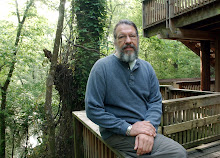Before i get started, those wishing to read more about Caddo Lake should check out 2 books:
Caddo Was... by Fred Dahmer, and Every Sun That Rises edited by T. Sitton and J.H. Conrad. Julie Dunand Amy, a friend who has been making very regular trips to Caddo Lake since she was a kid, loaned these 2 books to me. Like Caddo Lake itself, they are utterly fascinating books, both comprised of the words of 2 old-time lifelong residents of the lake, Fred Dahmer and Wyatt Moore.
two very typical views of the upper reaches of Caddo Lake
In the beginning of his book, Caddo Was . . ., Fred Dahmer pretty much nails it when he states, "the history of Caddo Lake is colorful, complex, and controversial." Honestly, there's no way that i could do it any justice in this lil' blog, so i guess i'll just focus on the most obvious highlights.
Before any white folks arrived, Caddo Lake was occupied by many many Kadohadacho (later slanged out to "Caddo") Indian villages. The Kadohadacho called the lake, Tso'to, which meant something like "sparkling water falling over red banks." By all accounts, the Kadohadacho were peaceful people who were known as big-time farmers, traders, and artisans by First Nation peoples from all over. Their lands stretched from Caddo Lake all the way south to present day Nacagdoches, TX. The Kadohadacho were said to be trading as far away as the Illinois Territory in 1715.
In fact -- and i hope i'm not digressing too much here -- it wouldn't surprise me if the Kadohadacho turned out to be the trading destination described by Spanish castaway Cabeza De Vaca, who was taken as a slave by the Karenkawa Indians in the early 1500s near present-day Galveston. After a few years, the Karenkawa Chief trusted De Vaca enough to designate him a trading emissary, sending him "several days north" with pots of fish oil and other goods to trade with a certain powerful trading group (the Caddo???) for spear points and other items not readily available to the Karenkawas.
Anyway, the first written/Caucasian mention of Tso'to lake was as "Sodo Lake" by a traveler named George Bonnell in 1840. That name eventually morphed into "Soda Lake," which roughly describes the southernmost portion of present-day Caddo Lake, near where Twelve-mile Bayou (near Mooringsport, LA just above Shreveport) is today. Interestingly, at about that same time, the lower end of Caddo Lake was also known as "Fairy Lake," thus designated on U.S. Army Corps of Engineer maps of the time. Later, "Fairy Lake" was corrupted to "Ferry Lake," a name which today serves as a place name for a tiny community on the northeastern end of Caddo Lake. See how colorful, complex, and controversial everything gets?
Long before Bonnell, the first Caucasians to reach Caddo Lake were the survivors of the 1685 LaSalle expedition. Five years later, it was again mentioned by ol' "Iron Hand" Tonti, LaSalle's right-hand-man, who himself had gotten separated from the expedition, and was looking for it. Only one year after Tonti, Spanish expeditionary leader Domingo de los Rios reached the Kadohadachos from the southwest. French from the east, Spanish from the southwest. Oh, them poor Indians! In no time, the French and Spanish became entangled in an ongoing battle for the Kadohadacho lands! And what did the Kadohadacho do? They supplied both sides with food and friendship, and attempted to act as peacemakers between them!
Fred Dahmer mentions that the word Tejas itself, meaning "friend," comes from the Caddo, who used it so often that the French and Spanish explorers thought that was the Caddo's name for their land. Thus, the territorial name of "Texas" was born.
The battle for Caddo land raged on for years. First, the French claimed it. Then they ceded it (and all of the Louisiana Territory) to Spain. Then Spain ceded it back to France. Then the French sold it to the U.S.
And yeah, you guessed it: in the meantime, white folks' whiskey, contagious diseases, and broken promises pretty much did the Caddo in. Shortly after the Louisiana Purchase, the U.S. and Spain (who owned present-day Mexico and Texas at the time) still had no idea who owned Caddo Lake -- nor the entire Sabine River drainage for that matter.
mercy sakes but it's dense up in he-ah
Even after the U.S. purchased the Caddo Lake site from the Kadohadacho in 1835, surveyors simply could not properly naviagate the site in order to draw up proper maps/boundaries between Louisiana and the Texas Territory (still owned by Spain). Thus, Caddo Lake and the entire Sabine River drainage became a de facto "No Man's Land" -- unclaimed by either side, and highly attractive to all manner of skallywags, n'er-do-wells, cult leaders, runaways, smugglers, etc. . . . . and that's where we'll pick up the story in 'on est parti au Grand Texas, part III' . . . stay tuned ya'll.






No comments:
Post a Comment